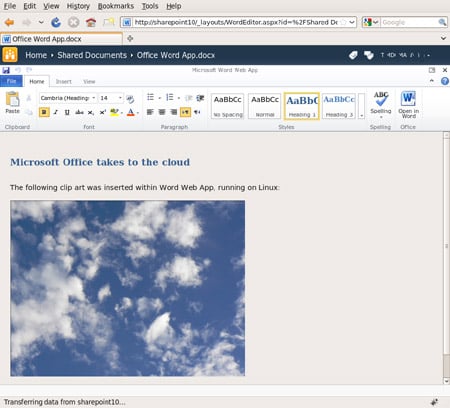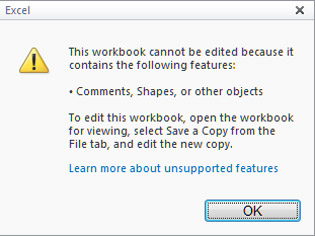Original URL: https://www.theregister.com/2010/04/27/office_2010_web_apps_review/
Microsoft's Office Web Apps - Google killing not included
Sharepoint power, cloud cracks
Posted in Channel, 27th April 2010 20:10 GMT
Review The most intriguing piece of an otherwise predictable Office 2010 - which volume customers can get as of Tuesday - is Office Web Apps.
These are the first ever, in-browser versions of Word, Excel, PowerPoint, and OneNote from Microsoft. They represent a significant break with the past for a suite that's been one of Microsoft's cash cows and resolutely stuck on the desktop, albeit with growing attachments to the server in recent years.
Microsoft's Web Apps will officially arrive with Office 2010 on May 12, and they come in two guises. The consumer version will be available on SkyDrive, part of Windows Live, and on Facebook through the just-announced docs.com, while businesses can install Office Web Apps as an add-on for SharePoint 2010. Even the free SharePoint Foundation is sufficient, though you do need a volume license for Office, and it is this version that I tested.
Office Web Apps are billed as a companion to desktop Office, rather than a replacement. Nevertheless, it is a real online suite. It's cross-platform on Windows, Mac, and Linux - though with some caveats. And it allows documents to be created, edited, viewed, and printed in the browser. Excel and OneNote even allow simultaneous editing by more than one user.

Office Web Apps work in Firefox and on Linux, if Moonlight isn't installed
The Web Apps are written mostly in JavaScript, and they'll run on browsers where Microsoft's media player Silverlight is not installed. But they take advantage of Silverlight for viewing documents when it is available. Printing is via Adobe Reader: the web app generates a PDF which is then opened in Reader for printing. On Windows - and provided that you have Adobe reader configured to open documents - this works smoothly. But on other platforms, it can be confusing, since you choose print but get a PDF download prompt.
Let's start with the positives. The Web Apps look good, and the chunky Office Ribbon is easy to use. The ribbon is annoyingly large on a netbook, but it can be hidden. SharePoint feels substantially more powerful with the Office Web Apps installed. The ability to view and edit documents without having to load Office is great, and I found myself enjoying it even when the full Office 2010 was available. It has obvious advantages for mixed Windows, Mac, and Linux networks.
Sharing
The distinctive feature of Office Web Apps is they use the same file formats as desktop Office, so there is normally no loss of fidelity or conversion hassle when editing online. You do have to use the new Open XML formats - the old binary formats, like .doc and .xls, work fine for viewing but cannot be edited in the browser. The other limitation is that if you include content in the document that the web app cannot handle, such as a Word Art object, then the web app will refuse to edit it in the browser.
PowerPoint works particularly well as a Web App. You can run your slide show from browser or use a feature called broadcast where you operate desktop PowerPoint, and you can publish the slide show on a Microsoft-hosted web app that can be viewed from anywhere on the Internet.
Rough around the edges
So far, so good. But there are plenty of annoyances. Performance is only fair, and while I did not see major bugs, I did notice some odd behavior, such as clicking in Word Web App and finding that the caret did not follow the click.
There are many inconsistencies. The buttons for opening a document in desktop Office depend on an ActiveX control or a Firefox plug-in that does not work in Firefox with Office 2007 or 2003 and only works on Windows. Another annoyance is Microsoft disables the ability to create documents in the browser if desktop Office is available, though you can get round this by using Chrome. A further inconsistency is that PowerPoint, Excel, and OneNote save on the fly, but Word makes you click Save.

Add the wrong kind of content to Excel,
and the Web App will refuse to edit it
I tried Office Web Apps with Firefox on Linux. It works fine, provided that Moonlight - the open source implementation of Silverlight - is not installed. But in this case, it nags you to install Silverlight. If you follow the prompts, they eventually lead you to Moonlight which breaks the Web Apps.
The Moonlight team is working on this and will probably fix it soon, but it shows that Microsoft apparently did not bother testing this combination, despite saying that Novell is its official partner for Silverlight on Linux.
There is also the matter of limited features. All the web apps are greatly simplified. In Word, you can apply paragraph styles but not modify them, and there is no find and replace, for example. Excel Web App offers no way to insert a new worksheet, or to run scripts.
In general, each web app has a minimal set of features, though there are occasional pleasant surprises like the Smart Art tools in PowerPoint Web Apps, or the ability to search and insert Microsoft's online clip art in Word Web App, with tools for scaling the image, though no way to apply borders.
The "G" question
An obvious question is how Office Web Apps compares to Google Docs. Google's offering is more mature, and it has the edge on features, performance, and cross-platform support. Google allows simultaneous multi-user editing in word processor as well as spreadsheet documents. But Google's document format is different, making Microsoft's online suite a better choice if you want to move documents back and forth between the cloud and the desktop. Despite their similarities, Google Docs and Office Web Apps meet different needs.
In the end, Office Web Apps both gains and suffers from its determination to live both on the desktop and in the cloud. Sometimes, the cracks show, like when you click to create a new document and get a dialog starting "Some files can harm your computer." Google and other pure cloud providers do not have this problem.
Even in their imperfect form though, Office Web Apps add real value to SharePoint, and their sheer convenience mitigates other failings. Flawed, but still a turning point for Microsoft Office. ®